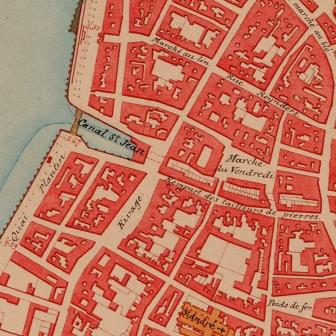Archeologisch onderzoek op Sint-Jansvliet (en)
About 800 years ago, there used to be a natural inlet, called Sint-Jansvliet, in the current location of the entrance to the pedestrian tunnel and the basketball court. Around 1200, this inlet was widened so boats could moor side by side. Over time, various markets were organised on either side of this inlet, such as the fruit market and the flax market. Sint-Janspoort Gate was situated at the junction of Hoogstraat and the inlet and consisted of a gate building and a bridge across the inlet. The gate was already demolished in 1581, which is why not many illustrations or plans exist of it. When the quays were renovated at Napoleon’s behest, the connection of the inlet with the Scheldt was widened and the medieval towers on the Scheldt side were demolished. The bridge to Sint-Janspoort Gate also disappeared after the inlet was vaulted and filled in in 1881.
The archaeologists expect to find the remnants of the quays walls of Sint-Jansvliet and possible remnants of dwellings that used to be on Sint-Jans bridge. The location of the old quays walls will be incorporated in the square’s final design to expose a part of Antwerp’s rich past again.


